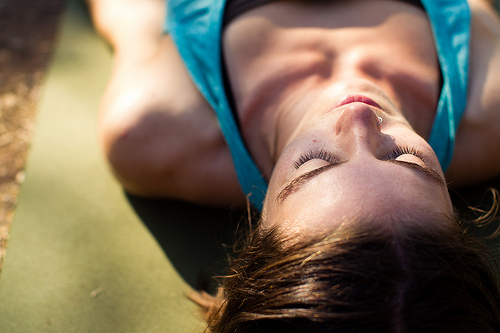My students have been coming into Yoga class pale and exhausted.
This long East Coast winter has been brutal.
I begin the class by suggesting they lie down; inviting them to find their breath, their heartbeat. We start with a restorative pose that opens their shoulders.
I encourage them to exhale.
After some time in stillness, I try to keep them busy and challenged, encouraging them to hold their attention where it is needed as we explore the poses.
Vinyasa yoga is good that way; you breathe in and do one thing; breathe out and do another. On a good day, suddenly there you are, anchored in the manageable present.
Truthfully, I know it is much more than the cold weather that has coaxed my students shoulders towards their ears. It is the barrage of stimulation that is New York City street life. It is also, the subways; the cell phones; desks; and computers. It is the modern stresses of jobs and families; a still broken healthcare system; and the daily news.
In a way though, these challenges unite us. They are part of the fabric of our sangha, and I know what I am working with.
But I will never know all of their stories.
While many of these students have been coming to class for months, or even years, they don’t say much. They unroll their mats in their favorite spot in the room. Some days they seem happy and other days more withdrawn, but they don’t ask me about their bodies or tell me about their lives.
I imagine that Yoga is their quiet time; a stretch of minutes during which they don’t have to answer questions or emails; or be present for anyone other than themselves. So I let them be.
Other students have a lot to say. Perhaps there are events going on in their bodies or their lives that are just too big not to share. For many, it is probably just their nature; they are friendly or gregarious. Their stories range from wild dates to achy hamstrings; new diets to grandchildren.
Last month though seemed particularly tough. There was illness; pets died; and a pregnancy was lost.
I admired these students, their courage and open natures, how they stuck to their practice. But it made me think about the quiet students too, and how we never really know what the person on the next mat is going through. Yet there we are together, side by side, in not too many clothes, moving and breathing and sweating.
As a teacher, on some days it can feel like a lot to hold. Occasionally, I get carried away by everything that I had hoped to teach, and it is not until class draws towards a close and the students are silently holding seated poses, that I remember again about the particular difficulties of one student or the drawn face of another.
Have I given them the right kind of class? Have I offered them the touch that they needed, or the words from the teachings that might make a difference? I am never sure.
Years ago, I settled on a kind of insurance plan. The Buddha might call it an antidote. In almost every class I teach, once the students are settled in Savasana (final resting pose), and don’t need any more instructions or eye pillows fetched, I sit and do a Metta practice (a meditation based on the strong wish for the welfare and happiness of others).
Sometimes it is just for a minute or two, sometimes longer. It is, of course, for myself as a teacher so that I accept that I can’t offer each of them a perfect class; a practice that is just right for their bum knee or their broken heart.
But it is also a reminder that I am ultimately there to offer my attention, and by resting my attention on the goodness of Metta, perhaps it will infuse the room and hold each of them with kindness as they get up and continue their lives.
Love elephant and want to go steady?
Sign up for our (curated) daily and weekly newsletters!
Editorial Assistant: Brandie Smith/Editor: Bryonie Wise
Photo: elephant archives











Read 0 comments and reply